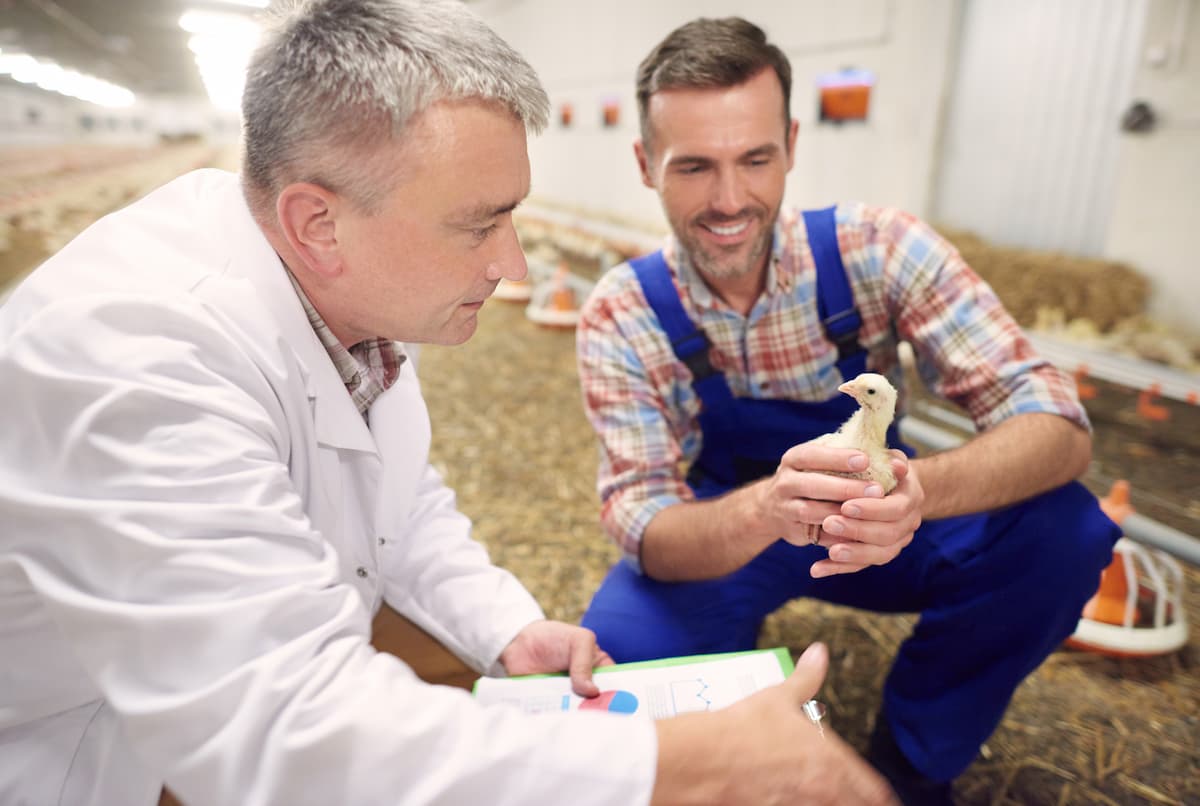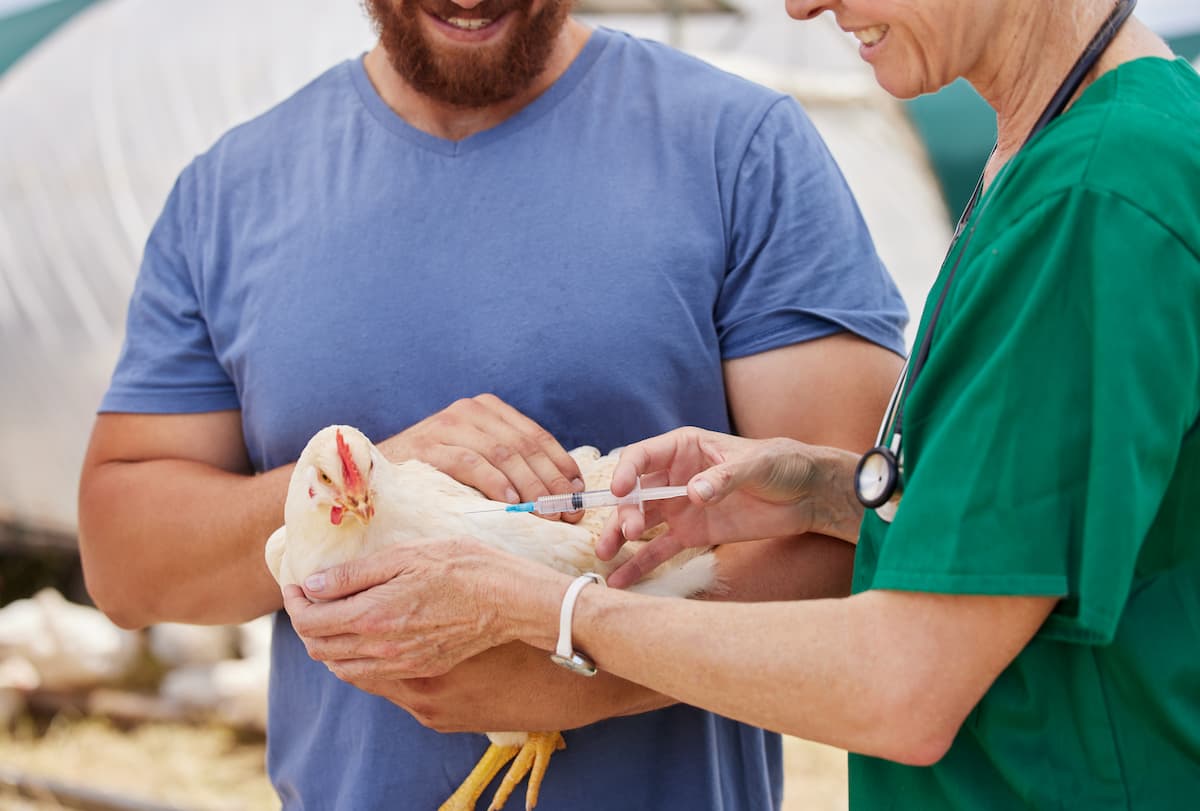Infectious Bronchitis (IB) is a viral respiratory disease that affects chickens and is caused by the coronavirus Infectious Bronchitis Virus (IBV). This disease is highly infectious and contagious and can affect chickens at any stage of their lives. However, young chicks, particularly those under six weeks of age, are more susceptible to the disease.

In addition to the respiratory system, IBV can also affect the oviduct and kidneys of chickens, causing further complications.
Infectious Bronchitis Management in Chicken
Causes of Infectious Bronchitis Disease
- Infectious Bronchitis (IB) is caused by the Infectious Bronchitis Virus (IBV), which belongs to the Corona group of viruses. IBV is a fragile virus and can be easily destroyed by common physical and chemical agents, including disinfectants and heat.
- The infection spreads through inhalation of droplets, ingesting contaminated feed and water, and contact with infected birds, contaminated equipment, clothing, and personnel. The virus is present in the respiratory discharges, feces, and eggshells of infected birds, making these a potential source of infection for healthy birds.
- The virus can survive well outside the bird’s body, particularly during winter. Therefore, the incidence and spread of the disease are often more common during the winter season. However, IB can occur in any season.
- The disease spreads rapidly in a flock, primarily through direct bird-to-bird transmission. The virus can also be transmitted through eggs, making vertical transmission possible. Fomites, such as equipment and clothing, can also transmit the virus.
Disease Cycle of Infectious Bronchitis
The disease cycle of Infectious Bronchitis (IB) typically involves the following stages:
- Incubation: After exposure to the virus, chickens enter an incubation period of 24-48 hours.
- Transmission: The virus spreads quickly between birds through direct contact or inhaling airborne virus particles.
- Replication: The virus replicates in the respiratory tract, particularly in the ciliated epithelial cells of the trachea and bronchi.
- Clinical signs: After the peak of virus excretion, clinical signs start to appear, such as respiratory signs (sneezing, coughing, gasping, etc.), conjunctivitis, and decreased egg production in laying hens.
- Recovery or death: The severity of the disease and outcome depends on various factors, such as the strain of the virus, the age and immune status of the chicken, and the presence of other infections. Mortality rates can range from negligible in adult birds to 25-60% in young chicks. Survivors may develop long-lasting immunity to the same strain of the IB virus, although new strains can cause disease.
- Shedding and reinfection: Recovered birds can shed the virus for several weeks after infection, leading to the reinfection of susceptible birds and contributing to the persistence of the disease in a flock.
Symptoms of Infectious Bronchitis Disease
Symptoms of Infectious Bronchitis Disease in chickens can vary depending on the age and type of bird affected. Some common symptoms include:
- Respiratory signs such as sneezing, coughing, gasping, tracheal rales, lachrymation, and nasal discharge
- Huddling under the hover
- Swelling of sinuses and face
- Mortality, which can be high in young chicks (up to 25%-60%)
- The course of the disease typically lasts 1-2 weeks in chicks.
- Respiratory noises that can be heard more distinctly at night
- Egg production declines rapidly in laying birds (5-50%)
- Damage to functional oviduct in adults, leading to egg abnormalities such as misshapen, thin or soft-shelled, rough, smaller, corrugated, and leathery eggs
- Poor egg quality with thin or watery white albumin
- Depression, ruffled feathers, wet droppings, and increased water intake in the uraemic form.
- Increased mortality (0.5-1% per week) due to urolithiasis (kidney stones) in uraemic form
In case you missed it: Infectious Bursal Disease Management in Chicken: Causes, Symptoms, Treatment, Diagnosis, and Prevention

Impact of Infectious Bronchitis
- IB has great economic importance because it can have a severe impact on egg production and quality in layers and production in broilers.
- The virus can cause reduced egg production, abnormal eggshells, and eggshell discoloration, which results in significant losses for poultry producers.
- Furthermore, other pathogens such as Mycoplasma or E. coli can increase the severity and duration of the disease, which can further exacerbate the economic impact of the disease.
Diagnosis of Infectious Bronchitis in Chicken
- To diagnose infectious bronchitis in chickens, a presumptive diagnosis can be made based on clinical signs and history. Still, confirmation is necessary due to the similarity of symptoms to other diseases.
- Serology can be used to diagnose the disease if an increase in antibody titers can be demonstrated, typically by taking two samples, one at the onset of the disease and the second 10 days later.
- It is also recommended to identify the serotype of the virus, particularly if vaccinated animals develop the disease. RT-PCR is recommended to identify the genetic type of the virus, which has replaced traditional serotyping to determine the strain’s identity.
Treatment and Control of Infectious Bronchitis Disease
- The treatment of infectious bronchitis is mainly supportive, and there is no specific medication to cure the disease.
- However, antimicrobial therapy can help reduce mortalities caused by bacterial infections that may complicate the disease.
- In cold weather, raising the temperature may reduce fatalities. Reducing protein concentrations in feed and providing electrolytes in drinking water may help with nephropathogenic strain outbreaks.
- Control of infectious bronchitis is based on the vaccination of birds, proper biosecurity measures, and management practices. Attenuated live and killed vaccines control the disease, but little or no cross-reactivity between types requires the correct vaccine type to be applied.
- Live-attenuated vaccines are initially given to 1- to 14-day-old chicks by spray, drinking water, or eye drop, and birds are commonly revaccinated approximately two weeks after the initial vaccination.
In case you missed it: Coccidiosis Disease Management in Chicken: Symptoms, Treatment, Prevention and Management of Disease

Preventive Measures of Infectious Bronchitis Disease in Chickens
- Vaccination: Vaccination is the most effective way to prevent the disease. Vaccination should be done using the correct serotype of the vaccine as the field strain.
- Control of rodents and insects: Pests such as rodents and insects must be under control as they can carry the virus.
- Isolation: Any new birds brought in should be isolated for at least two weeks before being introduced to the main flock. This will help to prevent the spread of the virus.
- Hygiene: Proper hygiene is important to prevent the spread of the virus. Handlers should wash their hands and wear protective clothing such as gloves and boots.
Conclusion
Infectious bronchitis is a highly contagious viral disease of chickens caused by a coronavirus. It affects the respiratory and renal systems and can also cause egg production losses in laying hens. The disease is spread through direct contact with infected birds and through aerosols, contaminated surfaces, and equipment.
Diagnosis of the disease requires laboratory testing, and treatment generally focuses on controlling secondary bacterial infections. Biosecurity practices are also important for preventing the spread of the disease, particularly in backyard flocks. Effective control of infectious bronchitis requires a combination of vaccination, biosecurity measures, and appropriate management practices.
- Types of Fungicides Used in Agriculture
- Common Issues in the Fruit Development Stage of Pomegranate Farming
- Fruit Development Issues in Papaya: Easy Solutions and Treatment
- Soil-Borne Diseases and How to Protect Your Plants
- Practices to Prevent Disease Spread in the Garden
- From Wilted to Thriving: How to Treat Root Rot Naturally in Houseplants
- Natural Remedies to Cure Brown Spots on Fig Tree Leaves
- Natural Solutions for Poinsettia Problems: 100% Effective Remedies
- How to Control Calla Lily Problems: Natural Remedies for Leaf and Flower Problems